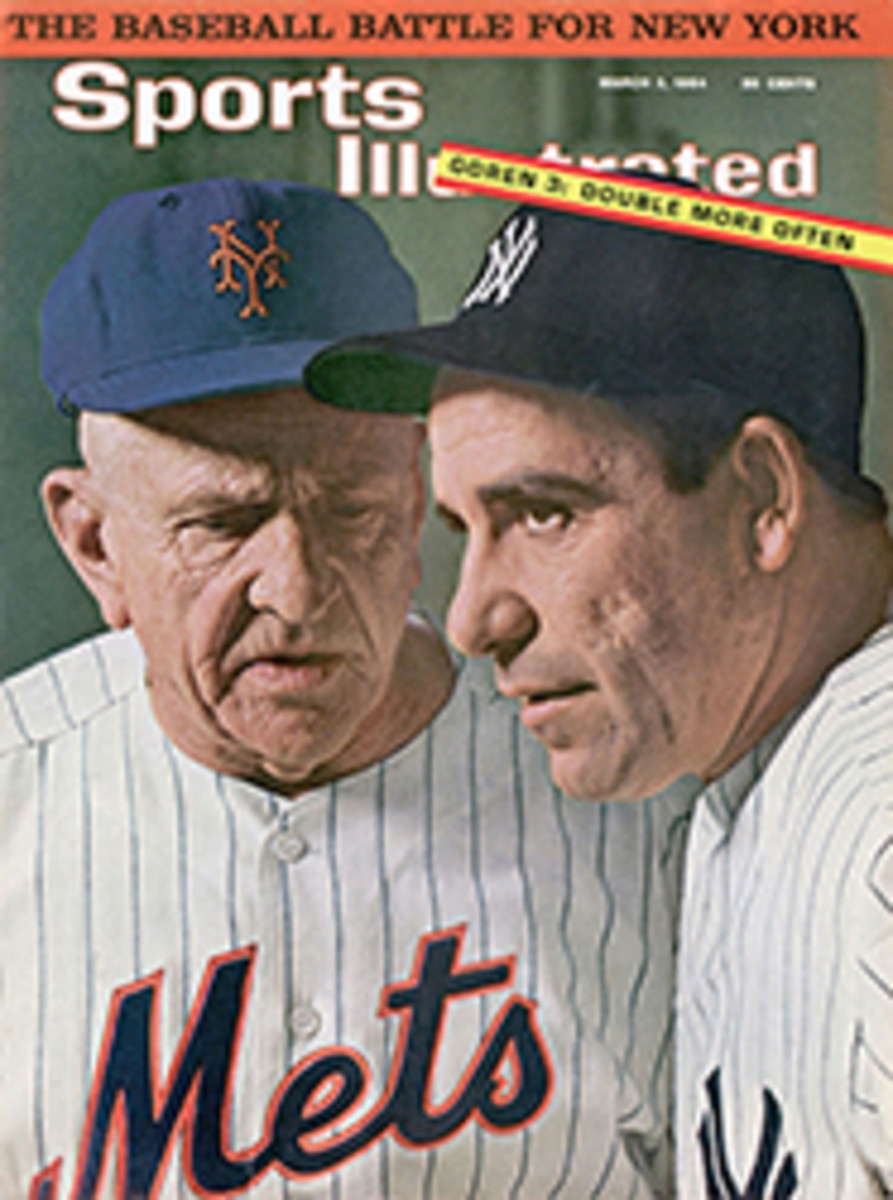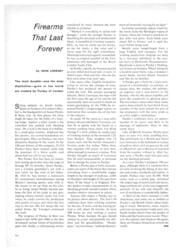
MEET THE NEW WILT CHAMBERLAIN
A strange thing happened at a National Basketball Association game in St. Louis early this season. The ball was thrown to the San Francisco Warriors' 7-foot-1[1/16]-inch 290-pound center, Wilt Chamberlain, who was positioned near the St. Louis Hawks' basket, and Chamberlain threw the ball right back out to one of his teammates. This maneuver so unsettled Ed Macauley, a former NBA center and a spectator at the game, that he nearly choked. "Chamberlain threw the ball out," he said, loosening his tie. "He actually threw the ball out!" If Macauley was surprised, so were the Hawks, who stood around in a state of deep shock while one of Chamberlain's teammates, cutting toward the basket, made the layup unmolested.
To understand the loss of composure by Macauley and the Hawks, you must remember that in previous seasons when the ball got to Chamberlain the rest of the Warriors would react as if they were watching a spectacular Pacific sunset. They would be open-mouthed and motionless, because Wilt Chamberlain leads the world in taking shots. But so often did the ball fly back out to a moving teammate that night that Chamberlain scored only 22 points, exactly 22.8 points less than he scored per game last year, and 28.4 less than the year before, when the big center averaged a phenomenal 50.4 points.
All this does not mean that Chamberlain is slipping. A year ago the San Francisco fan, paying his money to see Wilt play, got his 50 points' worth all right, but he still felt like someone who bought a Rolls-Royce only to discover that the horn didn't work. San Francisco fans had every right to expect perfection from such a specimen, but they not only did not get perfection, they did not get to see the Warriors win very often, and no citizen of San Francisco is going to stand for that very long. Eventually they began to leave the Warriors alone in alarming numbers, except when the champion Celtics would come to town, and then they came to root for Boston.
But that was last year. This season there is a new Wilt. The Warriors won their early game with the Hawks, mostly because Chamberlain was doing workaday things. He passed to his no-longer stationary teammates when they were clear, he raced back downcourt in order to block shots when St. Louis got the ball, and he gathered up rebounds on both backboards. Furthermore, Chamberlain has been playing this way for four months now. He is, to be precise, scoring less and having the time of his life.
So are the Warriors, a team that lists on its roster some of the slowest players and worst shooters ever to play in the NBA. With just 14 games remaining in the regular season, San Francisco—in next-to-last place this time last year and until recently the obvious choice to finish there again—is in first place, ahead of the St. Louis Hawks and the defending Western Division champions, the Los Angeles Lakers. There is a related phenomenon: the curious fans of early last year are back, along with quite a few brand-new ones. When they press the horn now they get a sturdy, melodious toot for their money.
There are, to be sure, critics who insist that the Warriors are first only because the Lakers are unlucky. They are right. The Lakers are unlucky. Their two best players, Elgin Baylor and Jerry West, have been hurt. When West was lost for two weeks with a broken thumb, they lost eight of their next nine games. But the critics are not right when they say the Warriors' lofty state is a fluke. "No fluke," growls Cincinnati Royal Coach Jack McMahon. "The Warriors are tough. Every game with them is all-out, dog-cat-dog, kick-'em-where-it-hurts warfare. Let up a little and they'll beat you to death." Why? How could such a bad team suddenly become so good? There are two reasons. The first, of course, is Chamberlain, a player Ed Macauley once called the worst in the world because he wasn't doing what he could do. Now he is one of the best because he is doing just that. The other reason is Alex Hannum.
Alex Hannum is a 6-foot-7, blue-eyed fellow who pops into hotel lobbies with mincing steps, grinning as if he were about to spring some outrageous prank like wearing a Beatle wig on his balding head. Hannum's hair first began to disappear in 1957, the year he took over as player-coach of a tired old St. Louis Hawks team and drove it to within two points of an NBA championship, losing to Boston in the seventh game in double overtime. The next year the Hawks went out and did it right, upsetting the Celtics, bringing great joy to St. Louis and a strange sort of tribute from Hawk President Ben Kerner. "Hannum," said Kerner, "is not my kind of guy."
So Alex Hannum went to the Syracuse Nationals, and one year nearly beat Boston in the playoffs. Winning was sweet, but Hannum was homesick for California. When the Nats deserted Syracuse for Philadelphia, Hannum deserted the Nats for Los Angeles and a job as a building contractor. A month before training camp opened, the Warriors' managing director, Eddie Gottlieb, put in a call to Hannum and offered him the San Francisco job.
"Does Chamberlain demand to play the full 48 minutes of every game?" Hannum asked.
"Absolutely not," Gottlieb said.
"Is Chamberlain going after points to insure his high salary?" Hannum then asked.
"Absolutely not," said Gottlieb.
"O.K.," said Hannum. "You got yourself a coach."
San Francisco had a coach, but what Hannum got was no bargain. The team had the morale of a bunch of recruits immediately after their first G.I. haircuts. Says Hannum, "I realized how completely inadequate the team had become. They had learned to depend on Wilt so completely they were even incapable of beating a squad of rookies. I had to convince them that they, too, had responsibilities."
Hannum demanded that the Warriors play all-out the entire time they were in a practice game, running constantly and finally cutting toward the basket or to an uncluttered spot for a jump shot. When a player began to bleed from the eyes, Hannum would send in a substitute. But the trouble was, these players had no stomach for continuous motion because they knew that if Chamberlain got the ball they would never see it again.
Hannum's next task, then, was to convince Wilt Chamberlain—the greatest scorer in history, the man who once scored 100 points in a single game, the man who holds eight of the 10 major scoring records—to let someone else shoot once in a while and to play defense with as much enthusiasm as he did offense. "For us to win," said Hannum, "Wilt has to play like Bill Russell at one end of the court and like Wilt Chamberlain at the other end of the court."
There were experts who were sure Hannum did not have a chance. "Chamberlain," said one eastern sportswriter, "is a loser. Has been all his life. Neither his college nor his pro team has ever won a title, because he won't take coaching. All he wants to do is score points." Alex Hannum, however, insists he had no trouble at all getting Chamberlain to play it his way. Whether he did or not, he obviously persuaded Wilt. And to a man, the Warriors were willing to give Hannum's battle plan a try. "What could we lose?" says Forward Tom Meschery. "Our shirts? We'd already lost those."
Chamberlain, of course, had quite a bit more than his shirt to lose, having parlayed his scoring talents into a $70,000-a-year job that enables him to drive a Bentley and to maintain apartments in San Francisco, Los Angeles and New York. He says now, "I don't care about points or my salary. All I care about is winning the NBA championship."
For those who insist that all this is just so much talk, there was a game in Philadelphia last month in which the Warriors came on the floor at half time trailing the 76ers by 15 points. In the next three minutes Chamberlain blocked four shots, picked up seven defensive and three offensive rebounds and was the playmaker, controlling the ball in one gigantic hand until a teammate was clear for a shot. Finally Hannum had to call a time-out so that his big center could stop laughing. The Warriors had outscored the 76ers 20-3, and Wilt's contribution was four points. Said Hannum, "He didn't exactly look like a man who was disappointed."
With Chamberlain now doing what everyone expected of him all along, San Francisco fans are coming back. They like him and his perpetual-motion supporting cast, and they like winning. About the only people not happy are the Warriors' opponents. The St. Louis Hawks' 6-foot-9, 240-pound Zelmo Beaty, for example, found out recently that he can no longer take Chamberlain's great strength for granted. Unable to slow Wilt down with conventional maltreatment, Beaty tried to yank his shorts off. Chamberlain, who can press 400 pounds without breathing hard, makes it a point to control his temper, primarily because he is genuinely afraid he might kill somebody. Beaty's unethical yank, however, was too much. Wilt flicked an arm, and Beaty flew across the floor like a man shot out of a cannon. Referee Mendy Rudolph rushed over to him and said: "For God's sake, stay down, man. Don't even twitch a muscle." Beaty didn't twitch, and he is still active in the NBA.
Baltimore's Terry Dischinger has a recurring nightmare. It was born the recent night the Warriors beat the Bullets 120-118. Dischinger got away from his man and went in for the last—tying—shot of the game. "I don't know whether the shot would have gone in," he said, "and I never found out. Wilt jumped up and grabbed it with both hands, and that was the game." To San Francisco's way of thinking, that is the game.
PHOTO
With one huge hand Wilt grabs a defensive rebound in Royal game. Previously this was a common sight only at other end of the court.

